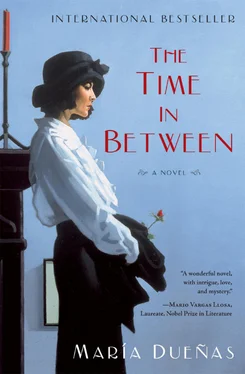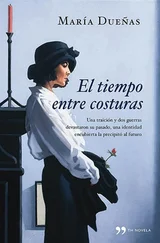“No problem,” I lied.
I didn’t have the slightest idea of what the hell an outfit for such an activity might be, but I wasn’t prepared to acknowledge my ignorance. I wouldn’t have admitted it even if I’d been standing before a firing squad. We consulted the magazines and examined styles. For the evening wear she chose creations from two of the great designers of the time, Marcel Rochas and Nina Ricci, selected from the pages of a French magazine with all the haute couture of the 1936 autumn/winter season. The ideas for the daywear came from the American Harper’s Bazaar : two outfits from the house of Harry Angelo, a name I’d never heard mentioned before, though I was extremely careful not to admit as much. Delighted at the array of magazines in my possession, the German lady made a great effort to ask me in her rudimentary Spanish where I had obtained them. I pretended not to understand her: if she were to learn of the wiles my business partner the Matutera used in getting hold of them, my first client would have been out the door as fast as her legs could carry her, never to be seen again. After picking the designs, we moved on to the choice of fabrics. With the samples that a variety of shops had supplied me with, I laid out before her a whole catalog whose colors and qualities I described for her, one by one.
It took relatively little time to reach a decision. Chiffon, velvet, and organza for the evening wear; flannel and cashmere for daytime. As for the pattern and fabric for the tennis outfit, we didn’t discuss that; I’d work it out when the time came. She stayed a long hour. Halfway through, Jamila, dressed in a turquoise caftan and with her huge dark eyes painted with kohl, made her silent appearance with a burnished tray carrying Moorish pastries and sweet tea with mint. The German lady accepted, delighted, and with a barely noticeable wink of complicity I conveyed my gratitude to my new servant. The final task was to take the measurements. I jotted the information down quickly in a leather-covered notebook: the cosmopolitan version of Doña Manuela into which I’d transformed myself was proving extremely useful. We agreed on a first fitting for five days later and said our good-byes with exquisite politeness. Good-bye, Frau Heinz, and thank you for the visit. Good-bye, Fräulein Quiroga, until next time. No sooner had I closed the door than I covered my mouth with my hand to stop myself from screaming and squeezed my legs together to stop myself from stamping on the floor like a wild colt. If I’d given free rein to my impulses, I would have let loose all the enthusiasm I felt at knowing that our first client had been snagged and there was no going back now.
I worked morning, afternoon, and night over the next few days. It was the first time I’d put together items of that scope all on my own, without the supervision or the help of my mother or Doña Manuela. I worked with all my senses, and then some, but even so, the fear of failure didn’t leave me for a second. I mentally took apart the outfits from the magazines, and when I couldn’t get any more out of the pictures I sharpened my imagination and intuited the things I wasn’t able to see. I marked up the materials with a bit of soap and cut pieces with as much fear as precision. I assembled, disassembled, and reassembled. I tacked, overcast, attached, took apart, and reconstructed on a mannequin until the result looked satisfactory. A lot had changed in fashion since I’d begun to move in that world of fabrics and threads. When I started at Doña Manuela’s workshop in the mid-twenties, loose lines were predominant; low waists and wide cuts for daytime, cleanly cut straight gowns of exquisite simplicity for the night. The thirties brought with them longer garments, fitted waists, bias cuts, prominent shoulders, and voluptuous outlines. Fashions were changing, just as times were changing, and with them the demands of our clientele and the dressmaker’s arts. But I knew how to adapt: I would have liked to be able to handle my own life with the same ease that I could accommodate myself to the whims of the fashion trends dictated from Paris.
Chapter Fifteen
___________
The first few days passed in a whirlwind. I worked without a break and went out little, just to take a quick walk as evening fell. At that hour I would usually run into one of my neighbors: the mother and son arm in arm from the apartment opposite me, two or three of the children from the upper floors racing down the staircase, a woman running home to prepare dinner. Only one shadow disturbed my activities during that first week: the wretched tennis outfit. Until I decided to send Jamila to La Luneta with a note: “I need magazines with pictures of tennis outfits. Doesn’t matter if they’re old.”
“Siñora Candelaria say Jamila come back tomorrow.”
So Jamila went back to the boardinghouse the next day and returned with a bundle of magazines she could barely carry.
“Siñora Candelaria say Siñorita Sira look these magazines first,” she told me in her sweet voice and awkward Spanish.
She’d arrived flushed with haste, buzzing with energy, brimming with hope. In a way she reminded me of myself in my early years at the workshop on Calle Zurbano, when my role was simply to run back and forth to do errands and make deliveries, moving through the streets agile and unconcerned as a street cat. I’d let myself get distracted by any little amusement that might allow me to steal a few minutes away, putting off my confinement between four walls as long as possible. Nostalgia threatened to bring me down, but in time I was able to withdraw and dodge it breezily: I learned to develop the skill of flight whenever I sensed melancholy approaching.
I threw myself anxiously into the magazines. All of them were out of date, many of them well thumbed, some even missing their covers. Few were fashion magazines, most were general in their subject matter. While some of them were French, by and large they were Spanish or from the Protectorate itself: La Esfera, Blanco y Negro, Nuevo Mundo, Marruecos Gráfico, Ketama. Several pages had their corners folded over; perhaps Candelaria had scanned through them already and was flagging pages for me. I opened them, and the first thing I saw wasn’t what I’d been expecting. In one photograph, two gentlemen with brilliantine-combed hair and dressed entirely in white shook hands over a net, while their left hands held tennis rackets. In another picture, a group of extremely elegant women were applauding as a trophy was handed over to a male player. I realized at this point that my note to Candelaria hadn’t specified that the tennis outfits had to be for women. I was about to call Jamila for her to go back to La Luneta when I let out a cry of delight. In the third magazine I found just what I needed. An extensive feature showed a woman tennis player in a light-colored sweater and a sort of split skirt, halfway between a normal skirt and a pair of broad trousers: something I’d never seen before, and probably neither had any of the magazine’s readers, judging by the detailed attention the photographs seemed to be paying to this piece of gear.
The text was in French and I could barely understand it, but a few references immediately stood out: the tennis player Lilí Álvarez, the designer Elsa Schiaparelli, a place called Wimbledon. Despite my satisfaction at having found a reference to the garment I was working on, this feeling was soon clouded over by a sense of unease. I closed the magazine and examined it carefully. It was old, yellowing. I looked for the date: 1931. It was missing its back cover and had stains on its edges, and some of its pages were torn. I was seized with worry. I couldn’t show an old relic like this to the German woman to ask her opinion about the outfit; it would overturn my whole false image as a sophisticated dressmaker on the cutting edge of fashion. I paced the house nervously, trying to find a solution, a strategy: anything I could use to resolve this unforeseen problem. After clattering back and forth along the hall tiles several dozen times, the only thing that occurred to me was to copy the design and try to pass it off as an original idea. But I had no idea how to draw, and the result would have been so clumsy that it would have brought me several rungs down the scale of my supposed pedigree. Unable to calm myself, I decided to resort to Candelaria one more time.
Читать дальше












